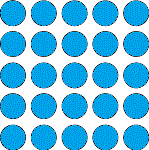Odd squares
Think of a number, square it and subtract your starting number. Is the number you're left with odd or even? How do the images help to explain this?
Problem
Think of a number.
Square it.
Subtract your starting number.
Is the number you're left with odd or even?
Try with other numbers.
What do you notice?
How do these images help you explain your observations?


Getting Started
Can you describe what is happening in the images?
What can you say about the pattern of dots on each side of the red line in the third image?
If there was a fourth picture, what could it look like?
What is the starting number in the picture?
Can you draw a similar series of pictures for different starting numbers?
Student Solutions
We had a variety of solutions sent in with different explanations. Here's the first that came to us and it's from Y6B from Newton Primary School:
If you start with an even number, the square will always be even. When you subtract any number from an even number, the answer is always even. It turns out even every time because if you start with an odd number, the square is odd, and if you subtract an odd number from an odd number, the answer is always even.
VISUALISATION: The visualisation of the dots helped us because you could see the dots that had been subtracted. You could see that there were the same number of dots on each side. There will always be the same number of dots on either side of the line because a square is symmetrical and so they have to have the same number either side of the line... odd+odd=even and even+even=even.
Abhishek got into algebra and sent in this neat solution.
The answer will always be even.
For example, let's say the number is $x$
so, $x^2 - x = x(x-1)$
which is the multiplication of two consecutive numbers, one of which will always be even.
And multiplication of an even and odd number is always EVEN.
Hafizur from Stepney Green Maths and Computing College London, also sent in a good explanation.
It will always be even because:
If an even number is multiplied by itself, another even, then you wil always end up with an even number. If you then take away from it another even number, itself, then you will be left with an even number.
Example:
$4\times4=16$ (even)
$16-4=12$ (even take away even is always even)
If an odd number is multiplied by itself, another odd number, then you willl always end up with an odd number. If you then take away from it another odd number, itself, then you will be left with an even number.
Example:
$7\times7=49$ (odd)
$49-7=42$ (odd take away odd is always even)
Teachers' Resources
Why do this problem?
Possible approach
Key questions
Possible extension
Possible support
